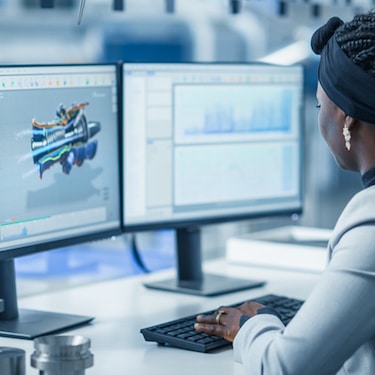When we think about a Digital Twin, what usually comes to mind is a product twin – i.e., a digital model of a product at a given time. The product Digital Twin is a dynamic asset that represents the product as it changes throughout its lifetime.
Digital knowledge of a product is valuable for many reasons. For example, it can be shared with people and applications for use in predictive maintenance, product improvement, and change management, to name a few. According to recent research, the global Digital Twin marketing size is projected to reach over $110 billion by 2030, with a CAGR of around 39%.
The value of Digital Twin for products is obvious. But have you thought about a process-oriented Digital Twin?
Types of Digital Twins
There are actually several types of Digital Twins that can be used in manufacturing. Let’s look at each type before considering process twins in more detail.
- Product Twin: Product models capture product definition and lifecycle activity, providing a digital source of as-designed, as-engineered data along with virtual representations of the product.
- Process Twin: Process models represent manufacturing processes and production activities that are used to create products and services. This can extend to post-manufacture, where a twin is used to maintain service and maintenance processes.
- Persons Twin: We all know about personal digital models—most of us have experienced online avatars, for example. Digital models of human resources help to automate the complex human side of manufacturing. It ensures that technicians are working with relevant skills, qualifications, activities, and experiences, and it can be leveraged for work assignments and compliance tracking.
- Spatial Twin: Spatial modeling is the virtualization of locations. Think of the Google Maps Street view that we all are familiar with. This kind of spatial twin can also be used in manufacturing for a workspace, a production line, or an entire factory. Spatial twins enhance your abilities to evaluate and understand the physical space where the product or process is in real time.
All of these applications are possible if you have a modern Manufacturing Execution System such as iBase-t’s Solumina solution that can capture and refine all of the manufacturing data needed to produce a true and accurate digital twin.
The value of process twins
While each type of Digital Twin has value for a manufacturer, the most important type may be the process twin. What makes the process twin so important? Is it because the DoD will hold up to 10% of the payment without it? That’s a compelling reason for some manufacturers. But more generally, a process Digital Twin opens up new ways to see, understand, and optimize manufacturing processes.
Here are just some examples of the power of the process Digital Twin.
- Operational improvements: A process Digital Twin can help identify problems in operations that might be missed otherwise. This is especially valuable in complex discrete manufacturing, where there are so many tangential and interrelated operations that may impact the finished product.
- Continuous improvement initiatives: A process twin should be part of any continuous improvement initiative. In fact, it is the critical missing piece for many manufacturers. By digitally modeling processes as well as products at all times, you gain a depth and breadth of insight that reaches all corners of an enterprise.
- Maintenance and service: We tend to think of processes as a manufacturing issue, but processes are also important in maintenance and service operations. These activities can be included in a process Digital Twin if your digital transformation includes post-production applications such as iBase-t’s Solumina MRO (Maintenance, Repair & Overhaul).
- Process mining: Process mining uses AI and digital data to discover problems or opportunities to improve processes with automation. But it only works as well as the data it is fed, and a process Digital Twin ensures up-to-date and accurate information.
- Change management: How will a product change affect processes? How will those process changes impact the larger enterprise, including suppliers and customers? A process Digital Twin provides a powerful way to answer these questions, based on historical data and the ability to model changes before implementation.
Are you ready?
We’ve only scratched the surface of how a process-oriented Digital Twin can help manufacturers improve their products and operations. This shouldn’t be surprising, since processes are at the heart of manufacturing.
Creating Digital Twins for processes requires a fully digitalized factory with a modern MES that can leverage the IIoT to capture complete process data. You may also want post-production applications like MRO so that your Digital Twin extends throughout a product/process lifetime.
If your company is just starting its digital transformation journey, consider making the process Digital Twin one of your goals so that you can choose technology solutions and vendors accordingly. If you’ve already built a smart factory, then it may be time to include the process Digital Twin in your toolbox of solutions.
Learn more about Digital Twins, Digital Threads, and how iBase-t supports and enables them.





